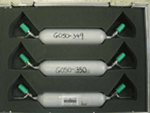More than two years after road access and electrical power to the Mauna Loa Observatory was cut off by lava flows, NOAA staff continue to make critical measurements of the atmosphere and other environmental variables at the remote site.
In 2023, observatory staff installed solar panels at the site and resumed some measurements, including the independent carbon dioxide monitoring programs run by the Global Monitoring Laboratory and Scripps Institution of Oceanography, as well as other atmospheric measurements.
Construction of a temporary road to access the observatory site is anticipated to begin in summer 2025.
Media can contact: Theo Stein (303) 819-7409 (theo.stein@noaa.gov)
Organization(s):
 CSIRO (Commonwealth Scientific and Industrial Research Organization) Atmospheric Research
CSIRO (Commonwealth Scientific and Industrial Research Organization) Atmospheric Research
What does this program measure?
CSIRO measures the following greenhouse gases (units of measurement are micromol per mol of dry air for Carbon Dioxide, and nanomol per mol of dry air for the others. The isotope ratios are measured per mil):
- Carbon Dioxide (CO2)
- Methane (CH4)
- Carbon Monoxide (CO)
- Nitrous Oxide (N2O)
- Hydrogen (H2)
- Stable isotopic CO2 Ratios (Carbon 12/13, and Oxygen 16/18)
How does this program work?
The trace gas mixing ratios are measured by the technique of gas chromatography; isotope ratios are measured with a stable isotope ratio mass spectrometer.
3 pairs of glass flasks are collected per month. CSIRO provides the glass flasks which are flushed and then pressurized with ambient air using a CSIRO-supplied pump. Sampling times are selected to maximize the probability of sampling undisturbed troposphere background air. Similar samples are collected at the other CMDL observatories (Point Barrow observatory, Trinidad Head observatory, Samoa observatory, South Pole Observatory). View the ESRL observatory information web page.
Why is this research important?
These trace species are being measured to better understand the processes underlying the long-term changes in the atmospheric abundances of these radiatively (and hence climatically) and chemically active trace species.
Another purpose of this project is to obtain values of the ratio 13C/ 12C in atmospheric CO2 at MLO and other locations for applications in modeling the global carbon cycle.
Are there any trends in the data?
Yes, there are trends in all species. The major greenhouse gases (CO2, CH4, N2O) are all increasing in abundance, although a pause in the growth of CH4 has been observed since 1999.
How does this program fit into the big picture?
What is it's role in global climate change?
These measurements of trace species in air samples collected at Mauna Loa Observatory are part of a global network of such observations.
Comments and References
Trace species data from this measurement program at the Mauna Loa Observatory are regularly submitted to international archives for such data (eg. CDIAC, at Oak Ridge, Tennessee, USA)
Please see: Langenfelds, R.L., R.J. Francey, B.C. Pak, L.P. Steele, J. Lloyd, C.M. Trudinger, & C.E. Allison, Interannual growth rate variations of atmospheric CO2 and its 13C, H2, CH4, and CO between 1992 and 1999 linked to biomass burning, Global Biogeochemical Cycles, Vol. 16, No. 3, 1048, doi:10.1029/2001 GB001466, 2002.
Lead Investigator(s):
Dr Paul Steele
011-613-9239-4578
Lisa Cooper
MLO Contact(s):
Steve Ryan
808-933-6965 (x235)
Paul Fukumura
808-933-6965 (x223)
Web Site(s)
Date Started
1984

